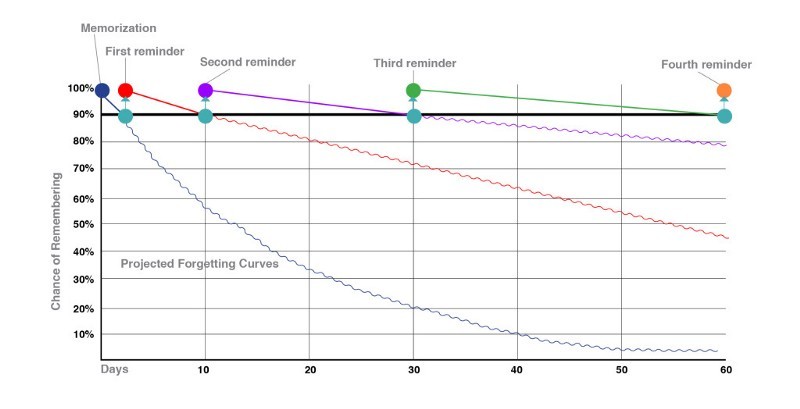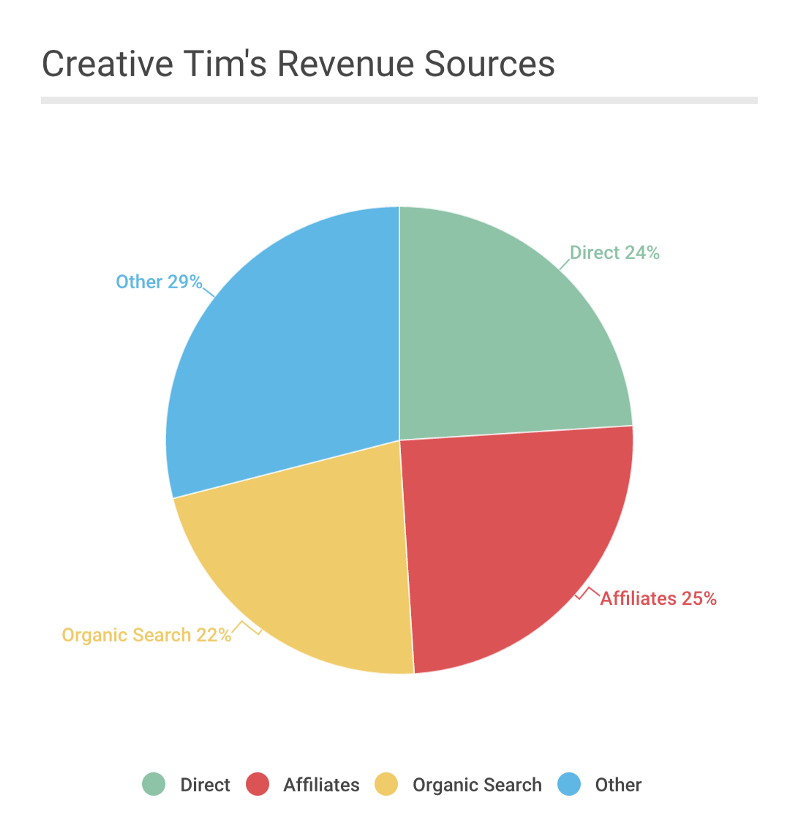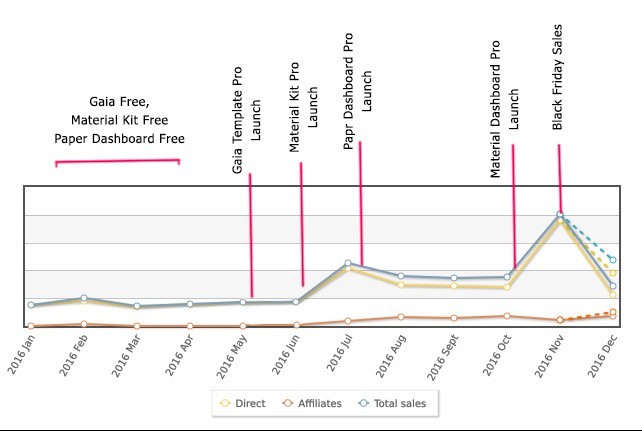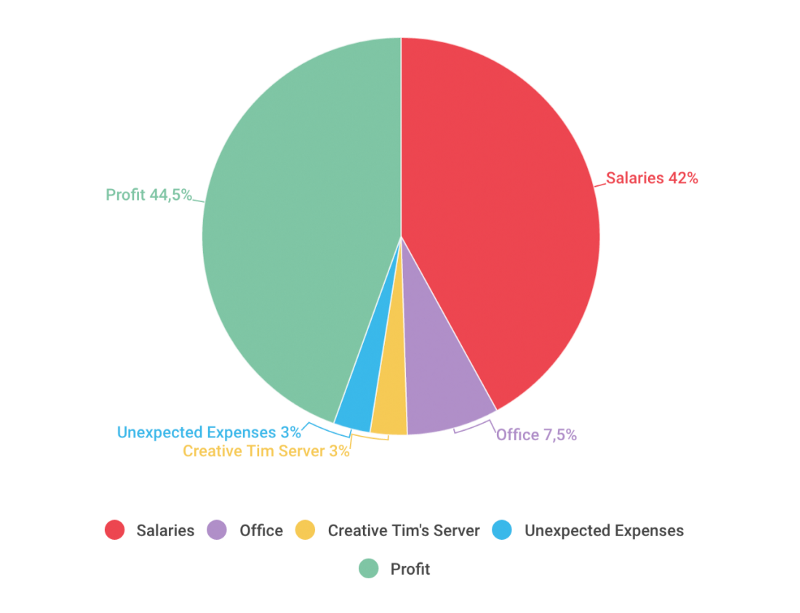How my friends and I pumped our third-party project to a business with an income of $ 17,000 per month
- Transfer
In 2014, my friends and I decided to create as cool web design tools as possible. We created UI kits , Admin Dashboards , Templates and Plugins .
We always dreamed of making web products useful for the development process, which we could use ourselves to create client sites.

In terms of revenue, apart from Black Friday with its sales (which helped us double our November 2016 profit), we grew to about $ 22,000 in revenue per month. Part of it goes to pay the commission for the affiliate program, VAT, supplier tax and other expenses. As a result, we currently have about $ 17,000 of monthly net income.
Today I want to share with you how we created our products and how we unwound this side business a bit.
We will cover the following topics:

What motivated us to start working on Creative Tim, and how we created the initial product.
We started work as a two-person agency in Romania without any outside investment. We did not have the means to rent a room for work — even just desks in a collective office — so we just worked at Starbucks. We barely managed to find money for our daily needs, fulfilling customer orders.
Creative Tim was a third-party project that, we were sure, would be useful for developers like us. We noticed that when working with clients we always “reinvent the wheel” and over and over again use the same elements for their sites. Therefore, we wanted to create several standard components, such as modal login / registration windows, calendars, headers, tips and footers.
For several months, we devoted our time to the implementation of the platform and some free lures (all this against the background of the main work). At the very beginning, we had neither followers on Twitter, nor fans on Facebook, nor email subscribers. We posted a lot of information about our free offers on the forums for designers and used the “tackle to web developers on Twitter” technique to let people know and start sharing information about our products.

How we attracted / got the first users
First of all, no one really understood what we want. They did not understand the full value of our ideas and what we can offer them for the development of their business. We decided that it would be better to create a more comprehensive product that could help people understand what we are doing.
We launchedGet Shit Done Kit , Bootstrap -based UI kit . We covered this event on Designer News website , which made the product more or less famous. We got 11,000 users from this resource, which has become a great support for our business.
Two weeks later, our startup appeared on Product Hunt . This has brought us more than 5,000 users. After that, the situation became stable: we moved from the point of "0 users per week" to a constant 2-3 thousand over the same period of time.

After a couple of months, inspired by the success of our free product Get Shit Done Kit, we released Get Shit Done Kit PRO - a premium version of GSDK with a large number of components and turnkey website pages.
Initially, we received only a few sales. The product brought about $ 200 a week, which was not enough to support our business. At the same time, we were working on a web project for one of our clients.
In December, we published at Bootstrap Expo, the most popular gallery for demonstrating sites created using Bootstrap. This was another impetus for the development of our business. Since everyone who visited the gallery for inspiration already knew what Bootstrap was or had already worked with it, so they became the ideal target audience for our business.
Later, we discovered the fact that getting traffic to the site is not enough to build long-term relationships with our users, and most of them forgot about our existence after the first interaction. We did some research and found out what most marketers probably have known for a long time: people forget things,
Therefore, we have implemented a system of email reminders, following the rules of the forget curve .

We wanted to remind our users that we exist and offer useful tools for working on their projects or their clients' projects.
At the moment, we are sending out letters according to the following schedule:
The marketing strategies we used to grow.

Most of our marketing strategies have come down to hosting content across communities like Reddit, Product Hunt, Designer News, Hacker News, and Github. Here are some of the important subreddits that work well for our industry:
/ r / web_design , / html5 , / r / frontend and / r / webdev .
We also paid a couple of times about $ 100-200 to send newsletter email campaigns. And although the investments turned out to be quite consistent with the amount spent, still this method did not live up to our expectations. However, perhaps this applies only to our specific activities, and in other cases it may prove to be justified.
Next, we paid $ 400 to get the Shit Done Kit PRO in the newsletter.Sidebar.io , as part of the list of the five best reference for designers made Sasha Grif (Sacha Grief). This newsletter was very successful for our project: we received about $ 1,500 in profit from sales.
Then we paid for the Review and Newsletter package (package $ 550) from eWebDesign . As a result, we got 5,000 users who shopped for $ 2,800.
We continued to think about where else we could find web developers who might be interested in our products, and realized that hackathons are exactly what we need.

Subsequently, we began to communicate with people who organize hackathons in order to offer them free licenses for our “premium products”. We have sponsored about 20 hackathons in different cities around the world: a list of them can be found here .
All developers were happy to receive free licenses, which we were glad to do: we were able to help people create good products faster, in addition, they found out about us, so this cooperation can be called mutually beneficial.
In addition, being presented at some hackathons, we learned a lot of information about how developers use our products and how we can improve them to make them more convenient for our users.
In March 2015, we completed work with agency contracts and switched from the “agency” mode to the “start-up” mode. With some savings in the bank and sales proceeds over the past few months, our team switched to full-time work on our startup. As we devoted more time to working on our projects and were constantly developing new products, our sources of traffic and revenue grew.

How our business model works
We realized that the best business model for Creative Tim is the Freemium model : we create a high-quality freebie that helps web developers create great websites, and then we implement PRO versions for this freebie that contain more elements, sections, modules and turnkey ready-made pages.
At the moment, we have 8 premium products, each of which has its own free buns. Their prices range from $ 19 to $ 599, depending on the license and archive type (HTML, HTML + PSD, HTML + Sketch). Freebies are found everywhere - in various communities, blogs, newsletters and social websites - and they drive all our traffic.
Our business model: create high-quality freebies that help web developers create great sites, and then implement the PRO versions for this freebie, which contain more elements.
The main idea is that these buns always appear in the top 10 large communities. Each post that is in the top 10 (depending on how large the community is) brings us from 1,000 to 15,000 targeted users per day. Imagine how much it would cost if you wanted to conduct a regular targeted marketing campaign?
Some examples:
Our sources of income

Direct sales of products
Here we have regular sales, which are made using our website, and make up 24% of the total sales. Excluding the Big Bundle .
Big Bundle
What is the Big Bundle, and how did we create it? We noticed that some of our users downloaded all of our free products. When I say everything, I literally mean all the products: they downloaded everything for about 2-3 minutes after they created the account. We also noticed that some of our customers bought all premium products.
Therefore, we decided to test our new product called “Big Bundle”, which gives you access to all our products with huge discounts (more than 60%). This large package was bought about 6-8 times a month. Since the prices of the Big Bundle are $ 299 (instead of $ 500) for personal use and $ 669 (instead of $ 2127) for a developer license, this is a good source of income and a great help for web designers and agencies who use our products for many projects. This is a win-win option.
Sales
partners We have created an affiliate network, and our distributors are very satisfied because they receive 50% for themselves from each transaction. For example, one of our most important partners operates within the framework of the popular GitHub repository: Bootstrap Material Design(17,000+ stars on GitHub). Currently, partners bring us about 25% of all revenue.
Organic Search (SEO)
We noticed that we also earn about 22% of our revenue through SEO. Therefore, we decided to invest more in SEO, we hired an SEO consultant who pays about $ 500 per month to improve the position of our products in Google search results.

Other income
The rest of our monthly income comes from Facebook, Twitter, and via the newsletter. This is how our income has evolved over time along with some historically significant moments, so you can follow how it grew in a few months:

And here is the cash spent that we commit:

The biggest lessons we learned for ourselves
It sounds corny, but owning some really great product is very significant and important.
Many of the founders of the business struggle to trade, breathing in what people do not want or what they do not need. If your product is crap, then there is not a single marketing strategy - and not a single source of investment - that could keep it alive for long.
Currently, more than 134,000 web developers worldwide use our products. We have users from Microsoft, Ubisoft, Vodafone, Orange, Harvard and Stanford universities and government agencies who download and use our products as various internal tools, we have also sponsored more than 20 global hackathons from 14 countries.
Do not strive to become the second Facebook. Try to solve the real problem instead.
Each step in our development seemed natural, we did exactly what needed to be done at that time. Looking back on the path of our evolution, we would not change anything. The only thing we could definitely do is faster the second time.
We have always created and improved our products based on feedback from our customers, and this is the best way to grow your business. It does not matter what you personally like - you need to make sure that you are offering a solution to a real problem for a real client.
Read, read, read.
Over the past three years I have read more books than in my entire life, and it makes me feel great.
Here are some of my favorite books that I recommend to everyone:
I really think that the secret weapon in the long run is the release of truly good products, combined with user experience and significant customer support.
The best solution we made was to bring our customers to the forefront and make sure that they received a complete UI kit / Dashboard that really solves their problems. This has been our guide throughout our journey.
Everything is possible.
We live in a world where anyone can become what he wants, as long as he is ready to invest the amount of time that is necessary to achieve this goal. I say time, not money, because we all have time. I would like to recommend two books that just say this:“Karaoke capitalism. Management for Humanity ”by Jonas Ridderstrale and Kjell Nordstrom and “ From Zero to One: How to Create a Startup That Will Change the Future ”by Peter Thiel (Co-founder of PayPal).
There are currently no restrictions. You can go to any place on the planet and connect with any person through social media. Today, even the most ordinary person can achieve more influence than the president of a small country. Just think of Instagram accounts with millions of followers. If I am an ordinary guy from Romania, I was able to build a profitable business in 2.5 years, which is 60 times the minimum monthly income in my country.
We always dreamed of making web products useful for the development process, which we could use ourselves to create client sites.

In terms of revenue, apart from Black Friday with its sales (which helped us double our November 2016 profit), we grew to about $ 22,000 in revenue per month. Part of it goes to pay the commission for the affiliate program, VAT, supplier tax and other expenses. As a result, we currently have about $ 17,000 of monthly net income.
Today I want to share with you how we created our products and how we unwound this side business a bit.
We will cover the following topics:
- What motivated us to start working on our startup, Creative Tim , and how we created our original product;
- How we got our first customers;
- The marketing strategies we used to grow;
- How our business models work;
- Secrets of our sources of income;
- The most important lessons we have learned.

What motivated us to start working on Creative Tim, and how we created the initial product.
We started work as a two-person agency in Romania without any outside investment. We did not have the means to rent a room for work — even just desks in a collective office — so we just worked at Starbucks. We barely managed to find money for our daily needs, fulfilling customer orders.
Creative Tim was a third-party project that, we were sure, would be useful for developers like us. We noticed that when working with clients we always “reinvent the wheel” and over and over again use the same elements for their sites. Therefore, we wanted to create several standard components, such as modal login / registration windows, calendars, headers, tips and footers.
For several months, we devoted our time to the implementation of the platform and some free lures (all this against the background of the main work). At the very beginning, we had neither followers on Twitter, nor fans on Facebook, nor email subscribers. We posted a lot of information about our free offers on the forums for designers and used the “tackle to web developers on Twitter” technique to let people know and start sharing information about our products.

How we attracted / got the first users
First of all, no one really understood what we want. They did not understand the full value of our ideas and what we can offer them for the development of their business. We decided that it would be better to create a more comprehensive product that could help people understand what we are doing.
We launchedGet Shit Done Kit , Bootstrap -based UI kit . We covered this event on Designer News website , which made the product more or less famous. We got 11,000 users from this resource, which has become a great support for our business.
Two weeks later, our startup appeared on Product Hunt . This has brought us more than 5,000 users. After that, the situation became stable: we moved from the point of "0 users per week" to a constant 2-3 thousand over the same period of time.

After a couple of months, inspired by the success of our free product Get Shit Done Kit, we released Get Shit Done Kit PRO - a premium version of GSDK with a large number of components and turnkey website pages.
Initially, we received only a few sales. The product brought about $ 200 a week, which was not enough to support our business. At the same time, we were working on a web project for one of our clients.
In December, we published at Bootstrap Expo, the most popular gallery for demonstrating sites created using Bootstrap. This was another impetus for the development of our business. Since everyone who visited the gallery for inspiration already knew what Bootstrap was or had already worked with it, so they became the ideal target audience for our business.
Later, we discovered the fact that getting traffic to the site is not enough to build long-term relationships with our users, and most of them forgot about our existence after the first interaction. We did some research and found out what most marketers probably have known for a long time: people forget things,
about which they do not remind.
Recently, we published a translation of an article on interval memory techniques that was created to help keep important information in your memory.
Therefore, we have implemented a system of email reminders, following the rules of the forget curve .

We wanted to remind our users that we exist and offer useful tools for working on their projects or their clients' projects.
At the moment, we are sending out letters according to the following schedule:
- After 3 days have passed since the first download, we send a letter recommending our other products;
- On the 10th day we send an email with a request for feedback and with a proposal to help if you have questions;
- On the 15th day, we remind you that the product can be upgraded to the PRO version;
- On the 30th day, we again ask for feedback and with an offer to promote the products of our users in our gallery or social networks;
- We send the final reminder on the 60th day.
The marketing strategies we used to grow.

Most of our marketing strategies have come down to hosting content across communities like Reddit, Product Hunt, Designer News, Hacker News, and Github. Here are some of the important subreddits that work well for our industry:
/ r / web_design , / html5 , / r / frontend and / r / webdev .
We also paid a couple of times about $ 100-200 to send newsletter email campaigns. And although the investments turned out to be quite consistent with the amount spent, still this method did not live up to our expectations. However, perhaps this applies only to our specific activities, and in other cases it may prove to be justified.
Next, we paid $ 400 to get the Shit Done Kit PRO in the newsletter.Sidebar.io , as part of the list of the five best reference for designers made Sasha Grif (Sacha Grief). This newsletter was very successful for our project: we received about $ 1,500 in profit from sales.
Then we paid for the Review and Newsletter package (package $ 550) from eWebDesign . As a result, we got 5,000 users who shopped for $ 2,800.
We continued to think about where else we could find web developers who might be interested in our products, and realized that hackathons are exactly what we need.

Subsequently, we began to communicate with people who organize hackathons in order to offer them free licenses for our “premium products”. We have sponsored about 20 hackathons in different cities around the world: a list of them can be found here .
All developers were happy to receive free licenses, which we were glad to do: we were able to help people create good products faster, in addition, they found out about us, so this cooperation can be called mutually beneficial.
In addition, being presented at some hackathons, we learned a lot of information about how developers use our products and how we can improve them to make them more convenient for our users.
In March 2015, we completed work with agency contracts and switched from the “agency” mode to the “start-up” mode. With some savings in the bank and sales proceeds over the past few months, our team switched to full-time work on our startup. As we devoted more time to working on our projects and were constantly developing new products, our sources of traffic and revenue grew.

How our business model works
We realized that the best business model for Creative Tim is the Freemium model : we create a high-quality freebie that helps web developers create great websites, and then we implement PRO versions for this freebie that contain more elements, sections, modules and turnkey ready-made pages.
At the moment, we have 8 premium products, each of which has its own free buns. Their prices range from $ 19 to $ 599, depending on the license and archive type (HTML, HTML + PSD, HTML + Sketch). Freebies are found everywhere - in various communities, blogs, newsletters and social websites - and they drive all our traffic.
Our business model: create high-quality freebies that help web developers create great sites, and then implement the PRO versions for this freebie, which contain more elements.
The main idea is that these buns always appear in the top 10 large communities. Each post that is in the top 10 (depending on how large the community is) brings us from 1,000 to 15,000 targeted users per day. Imagine how much it would cost if you wanted to conduct a regular targeted marketing campaign?
Some examples:
- Paper Kit - 380 votes on Reddit
- Material Kit - 560 votes on Reddit
- Light Bootstrap Dashboard Angular - 210 votes on Reddit
- Material Kit - 180 votes of Hacker News (the highest peak - 9th place: with 14,000 clicks to our website in 1 day)
- Material Kit - 860 votes on Product Hunt
Our sources of income

Direct sales of products
Here we have regular sales, which are made using our website, and make up 24% of the total sales. Excluding the Big Bundle .
Big Bundle
What is the Big Bundle, and how did we create it? We noticed that some of our users downloaded all of our free products. When I say everything, I literally mean all the products: they downloaded everything for about 2-3 minutes after they created the account. We also noticed that some of our customers bought all premium products.
Therefore, we decided to test our new product called “Big Bundle”, which gives you access to all our products with huge discounts (more than 60%). This large package was bought about 6-8 times a month. Since the prices of the Big Bundle are $ 299 (instead of $ 500) for personal use and $ 669 (instead of $ 2127) for a developer license, this is a good source of income and a great help for web designers and agencies who use our products for many projects. This is a win-win option.
Sales
partners We have created an affiliate network, and our distributors are very satisfied because they receive 50% for themselves from each transaction. For example, one of our most important partners operates within the framework of the popular GitHub repository: Bootstrap Material Design(17,000+ stars on GitHub). Currently, partners bring us about 25% of all revenue.
Organic Search (SEO)
We noticed that we also earn about 22% of our revenue through SEO. Therefore, we decided to invest more in SEO, we hired an SEO consultant who pays about $ 500 per month to improve the position of our products in Google search results.

Other income
The rest of our monthly income comes from Facebook, Twitter, and via the newsletter. This is how our income has evolved over time along with some historically significant moments, so you can follow how it grew in a few months:

And here is the cash spent that we commit:

The biggest lessons we learned for ourselves
It sounds corny, but owning some really great product is very significant and important.
Many of the founders of the business struggle to trade, breathing in what people do not want or what they do not need. If your product is crap, then there is not a single marketing strategy - and not a single source of investment - that could keep it alive for long.
Currently, more than 134,000 web developers worldwide use our products. We have users from Microsoft, Ubisoft, Vodafone, Orange, Harvard and Stanford universities and government agencies who download and use our products as various internal tools, we have also sponsored more than 20 global hackathons from 14 countries.
Do not strive to become the second Facebook. Try to solve the real problem instead.
Each step in our development seemed natural, we did exactly what needed to be done at that time. Looking back on the path of our evolution, we would not change anything. The only thing we could definitely do is faster the second time.
We have always created and improved our products based on feedback from our customers, and this is the best way to grow your business. It does not matter what you personally like - you need to make sure that you are offering a solution to a real problem for a real client.
Read, read, read.
Over the past three years I have read more books than in my entire life, and it makes me feel great.
Here are some of my favorite books that I recommend to everyone:
- How to win friends and influence people - Dale Carnegie;
- From zero to one: How to create a startup that will change the future - Peter Thiel;
- It will not be easy. How to build a business when there are more questions than answers - Ben Horowitz;
- Law of Success - Napoleon Hill ;
- Think and Grow Rich - Napoleon Hill;
- From good to better - Jim Collins;
- Business from scratch - Eric Rees;
- Charisma. How to influence, persuade and inspire - Olivia Fox Cabane;
- Lean Analytics: Use Data to Build a Better Startup Faster - Alistair Kroll.
I really think that the secret weapon in the long run is the release of truly good products, combined with user experience and significant customer support.
The best solution we made was to bring our customers to the forefront and make sure that they received a complete UI kit / Dashboard that really solves their problems. This has been our guide throughout our journey.
Everything is possible.
We live in a world where anyone can become what he wants, as long as he is ready to invest the amount of time that is necessary to achieve this goal. I say time, not money, because we all have time. I would like to recommend two books that just say this:“Karaoke capitalism. Management for Humanity ”by Jonas Ridderstrale and Kjell Nordstrom and “ From Zero to One: How to Create a Startup That Will Change the Future ”by Peter Thiel (Co-founder of PayPal).
There are currently no restrictions. You can go to any place on the planet and connect with any person through social media. Today, even the most ordinary person can achieve more influence than the president of a small country. Just think of Instagram accounts with millions of followers. If I am an ordinary guy from Romania, I was able to build a profitable business in 2.5 years, which is 60 times the minimum monthly income in my country.
